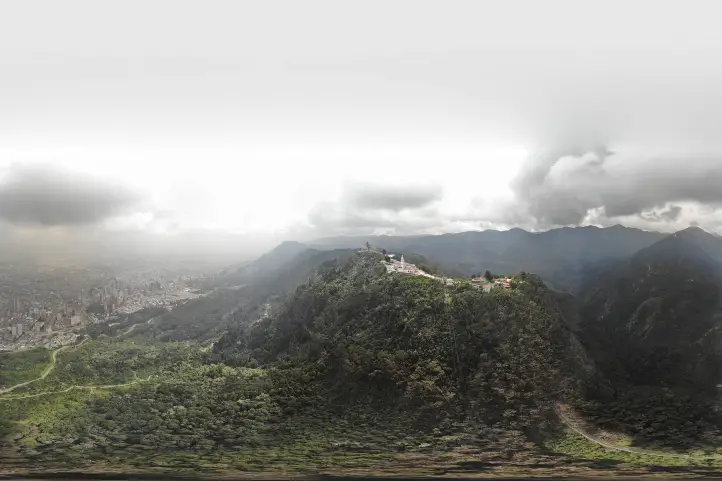Monserrate Hummingbird is the New Highlight of Monserrate Hill in Bogotá
The Monserrate Hummingbird is the new hummingbird hybrid recently discovered on the ecotourism trails of Monserrate hill in Bogotá.
Monserrate is the most prominent tourist attraction in Bogotá. It is 3000 meters high, and it is placed over the eastern hills of the eastern cordillera of the colombian Andes.

The Paramuno Ecological Trail
The Monserrate hill inaugurated a new ecotourism corridor for bird watching at the end of 2020. The trail received the name of “Paramuno”.
“Paramuno” is an ecological trail located at the top of Monserrate and has 360-meter long. There you can appreciate the forests and cotemplate nature. It is a path designed to watch and photograph birds.
Because it is located at the top of Monserrate, you can observe a variety of birds typical of the High Andean Forest ecosystem.
The trail is easy to access and it is over a flat terrain. The tour is easy to follow; likewise, the best conditions of security, attention and service are provided.
Paramuno trail honors the hummingbird species Shining sunbeam (Aglaeactis cupripennis), called Paramuno in Spanish.
The Shining sunbeam is a predominant species of the high mountain environments. It is common not only in Bogotá, but throughout the country.
The place is so important, that Reuters Agency invited people to visit the trail, calling it a “Hummingbird sanctuary provides respite from stresses of Bogota city life“.
Several feeders frame the path, and allow visitors to appreciate different species of hummingbirds. Among them, the Paramuno, which can be distinguished by its cinnamon color.
Up to 18 different species of high mountain hummingbirds can be seen in the ecological corridor. So far, up to 115 species of birds, and some migratory species, have been recorded along the Paramuno trail.
Among them, the Silvery-throated Spinetail (Synallaxis subpudica), a species endemic to the departments of Cundinamarca and Boyacá; the Coppery-bellied puffleg (Eriocnemis cupreoventris), the Rufous-browed conebill (Conirostrum rufum), and the Golden-fronted whitestart (Myioborus ornatus), and almost endemic species, which have a fairly restricted distribution in the country.
The Monserrate Hybrid
This small and impressive new jewel of the hummingbirds of Colombia, has been the focus of attention of several birders in Bogotá.
It was on Paramuno where the hybrid hummingbird was discovered. This supposed hybrid seems to be the product of the crossing of two species that in theory could not mate.
“This new hummingbird may be a cross between the Golden-bellied starfrontlet (Coeligena bonapartei) and the Blue-throated Starfrontlet (Coeligena helianthea). It is believed to be a hybrid because it has coloration that is intermediate between these two species”
Said Camilo Cantor, the trail manager.
These two species do not share territory. Each of them lives on a different side of the mountain range. That makes the appearance of the hybrid even more misterious and special.
El "Híbrido de Monserrate" un ejemplar único, que nos invita a conocerlo y protegerlo
💘Una plumita al aire entre coeligenas helianthea/bonapartei@cerromonserrate @ernichaves@Pablo_Andres@diegoetorres@oswaldoaves@DavidCasas11@AHummingbirds@herrinsa@patkensuno@maurobucaro pic.twitter.com/zuLfWlMQJT— Luz Sthella Cardona M (@cuzy317) February 25, 2021
The Origin of the Hybrid
Yet, the ornithologist and tourist guide, Oswaldo Cortés, talked about two possible origins of the hybrid.
One of them is that it may be a hybrid between Golden Bellied starfrontlet and Blue-throated Starfrontlet. The second guess is that it may be a genetic mutation of some individuals of the Blue-throated Starfrontlet.
The discovery of this bird has caused a great stir, and today it is one of Monserrate’s bird highlights.
The Importance of Hummingbirds and Conservation
More than bright colors and an undisputed beauty, hummingbirds have a fundamental role as pollinators, some of them associated exclusively to native plant species.
Colombia is the country with the most hummingbird species in the world. Currently there are approximately 165 species of hummingbirds registered in Colombia.
Find the 17 most interesting species in our blog 17 Unique Hummingbirds of Colombia and Where to Find Them.
Sadly, both, hummingbirds and their natural habitat are at risk. The vegetation in the Monserrate reserves has been greatly affected by man’s hand.
For this reason, work has been carried out to recover the ecosystem and the forests in the area. Discoveries like this bird are a great motivation to continue with the recovery and conservation of these forests.
Your visit is also important because it helps to generate more awareness about the value of birds. It also generates employment for local people, and ultimately represents an economic incentive to continue protecting and conserving our natural wealth.
Know more about the birding hotspots in Bogotá in our entry Where to go for Birdwatching in Bogotá? Complete Bogotá Bird Guide.
Recommendations for the Visit
To make your visit to the Paramuno Ecological trail you can book directly on Monserrate’s website, or contact us.
- Wear comfortable and warm clothing.
- Use sunscreen.
- As a precaution, children under 10 years old are not allowed.
- Follow all the recommendations of the Supervisor of the trail.
- Be punctual.
It is forbiden:
- The use of playback.
- Leaving waste on the trail.
- Feed the birds.
- Jumping over guard rails and fences.
- Pets.
If you want to plan your trip to Colombia do not hesitate to contact us, visit our Plan your trip page!
References
- bogota.gov.co
- Oswaldo Cortés – Bogotá Birding.
- Monserrate’s website.
About the author
Sara Colmenares
Current director of Sula. Doctor in Biological Sciences. Her main interests are to explore and understand the organism – environment interactions, taking advantage of emerging knowledge for the management and conservation of species and ecosystem services. She is currently working as a consultant in functional ecology, ecosystem services and conservation projects in Colombia related to ecotourism and birdwatching.